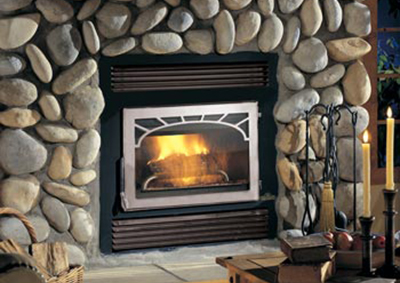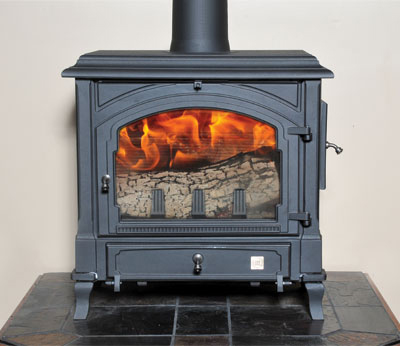The Benefits of a Fireplace

A fireplace can reduce your dependence on central heating to create a warm and comfortable living environment during winter. When the cold weather arrives, many homeowners resort to using a furnace or heat exchanger. With a fireplace, however, you can reduce your dependence on central heating. You build a roaring-hot fire inside your fireplace’s firebox that radiates throughout your home. You may still have to turn on your furnace or heat exchanger on particularly cold winter days, but with a fireplace, you won’t have to use central as frequently as you normally would.
You’ll also reap the benefits of a more relaxing living environment with a fireplace. Wood fires produce a dazzling display of flames that many people find relaxing to watch. Combined with its pleasant aroma, a wood fire will create a more enjoying and relaxing environment inside your home.
It shouldn’t come as a surprise to learn that fireplaces have become an increasingly popular feature in modern-day homes. According to The Washington Times, six in 10 new homes constructed in the United States have a fireplace. In comparison, only 36% of homes built in the 1970s have a fireplace. Based on these statistics, you can rest assured knowing that fireplaces are a popular feature in modern-day homes.
Not only are they are popular, but fireplaces can increase the value of a home. Research shows that homes with a fireplace sell for a higher price than those without a fireplace. An infographic published by Angie’s List suggests that fireplaces increase the value of a typical home by an average of $1,000 to $4,999. Maybe it’s because they save money on central heating costs, or perhaps it’s because they promote a more relaxing living environment. Regardless, homes with a fireplace typically sell for a higher price than those without a fireplace.
The Benefits of a Wood-Burning Stove

Wood-burning stoves aren’t as popular as fireplaces, but that doesn’t necessarily mean they aren’t effective. Like a fireplace, a wood-burning stove can help warm your home during the otherwise cold winter months. Wood-burning stoves, in fact, are actually more efficient at converting wood to heat than fireplaces. Wood-stoves approved by the U.S. Environmental Protection Agency (EPA) have an average efficiency of about 70%. What does this mean exactly? It means wood-burning stoves convert roughly 70% of the wood’s organic matter to heat. To put that number into perspective, fireplaces have an average efficiency of about 20% to 25%. Therefore, wood-burning stoves are up to three times more efficient than fireplaces.
The high efficiency of wood-burning stoves can be attributed to their design. They are smaller and more compact than fireplaces, allowing them to project more heat into your home. Fireplaces often lose a substantial amount of heat where the firebox connects to the flue. With their smaller firebox, as well as the use of a ventilation pipe rather than a flue, wood-burning stoves are more efficient at producing heat.
You can further increase the heating power of a wood-burning stove by using the right type of firewood. Available for sale here at Cutting Edge Firewood, our signature chiminea wood stove firewood is the perfect fuel for a wood-burning stove. Wood-burning stoves have smaller fireboxes than fireplaces. As a result, they may not accommodate standard-size wood logs. Our chiminea wood stove firewood features an assortment of compact wood logs, making them ideal for a wood-burning stove. You can use chiminea wood stove firewood in a fireplace as well, but its small and compact size makes it the perfect choice for a wood-burning stove.
A wood stove will provide the same relaxing atmosphere as a fireplace. You can position your sofas, chairs and other living room furniture around your wood-burning stove. During the evenings, this will allow you and your family to relax in front of a memorizing wood fire.
When compared to fireplaces, most homeowners will agree that wood-burning stoves are easier to maintain. Since wood-burning stoves have a ventilation pipe rather than a flue, they require less work to maintain. With that said, you should still have both your wood-burning stove, as well as the chimney, professionally inspected at least once a year.
Which One Is Best?
You can’t go wrong with either a fireplace or wood-burning stove. While they offer their own unique benefits, they will both allow you to build roaring-hot fires inside your home. Just remember to use the right type of firewood.Wood-burning stoves and fireplaces require high-quality firewood. Wet or damp wood, as well as softwood varieties of firewood, won’t cut it. Whether you have a wood-burning stove or a fireplace, you need to use high-quality kiln dried firewood. Doing so will allow you to build hotter, cleaner fires inside your home.
Experience the difference kiln dried firewood makes in your fireplace or wood-burning stove by visiting our online store today. Cutting Edge Firewood is the Southeast’s premier vendor of high-quality kiln-dried firewood. We offer a variety of the industry’s finest firewood, including oak, hickory, cherry and more, all of which you can use in your fireplace or wood-burning stove.
For more details on the Matrix, contact The Fireplace Shop and Grill Center at West Sport in Sudbury.
Source: cuttingedgefirewood.com

Comments
{tag_commentlist}